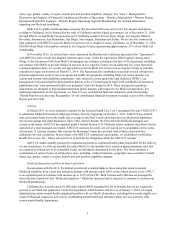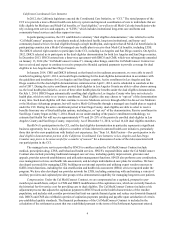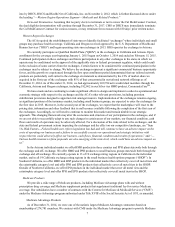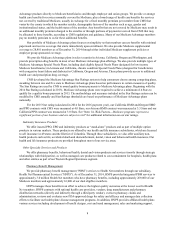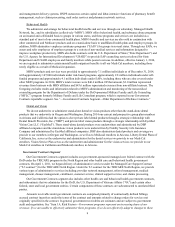Health Net 2014 Annual Report Download - page 17
Download and view the complete annual report
Please find page 17 of the 2014 Health Net annual report below. You can navigate through the pages in the report by either clicking on the pages listed below, or by using the keyword search tool below to find specific information within the annual report.15
Cognizant a break-up fee of $10 million. If we terminate the Master Service Agreement following the Commencement
Date for reasons other than cause, a termination of the associated Business Associate Agreement, a change in the
control of Cognizant or Cognizant becoming a competitor of ours, we shall pay Cognizant termination fees calculated
on a sliding scale that reduces over time and based on the applicable termination event, and such fees could be material.
For example, the maximum termination fee payable by us pursuant to the Master Services Agreement is $300 million,
which would be triggered in the event we terminated for convenience during the first year of the term of the Master
Services Agreement. In addition, in the event we experience a change in control during the first year of the term of the
Master Services Agreement, the maximum termination fee payable is $130 million, assuming that we (or our successor)
elect to terminate the Master Services Agreement.
We also retain the right to obtain disengagement assistance from Cognizant to facilitate the transition of BP and
IT Services from Cognizant, regardless of whether the Master Services Agreement expires or is terminated. We will pay
for the disengagement assistance through a combination of pre-determined charges and hourly fees for services for
which there is no pre-determined charge. In addition, in the event of termination or expiration of the Master Services
Agreement, we also retain the right to license at fair market value the software platform utilized by Cognizant in the
performance of the BP and IT Services.
Cognizant has in the past provided, and may provide in the future, services to us under separate agreements.
Some of these historical services are included in the BP and IT Services that will be provided by Cognizant under the
Master Services Agreement.
The Cognizant Transaction is subject to certain risks and uncertainties, including with respect to the receipt of
required regulatory approvals, which are discussed in further detail in "Item 1A. Risk Factors."Marketing and Sales
We market our products and services to individuals and employer groups through internal sales staff, independent
brokers, agents and consultants and through the Internet and the new ACA-mandated exchanges. For our group health
business, we market our products and services utilizing a three-step process. We first market to potential employer
groups, group insurance brokers and consultants. We then provide information directly to employees once the employer
has selected our health coverage. Finally, we engage members and employers in marketing for member and group
retention. For our large group business, in general, we solicit enrollees from the employee base directly during “open
enrollment” periods when employees are permitted to change health care programs. We use a variety of techniques to
attract new enrollees and retain existing members, which at times include, without limitation, direct mail, work day and
health fair presentations and telemarketing. Similar methods are used by our Medicare business to market to eligible
individuals. Our sales efforts are supported by our marketing division, which engages in product research and
development, multicultural marketing, advertising and communications, and member education and retention programs.
Several states in which we operate, including California and Arizona, have launched health insurance exchanges in
response to the ACA. The establishment of the exchanges under the ACA created a new competitive insurance
marketplace for individuals and small businesses. As these exchanges mature, we intend to refine and enhance our
exchange related marketing strategies.
Premiums for each employer group are generally contracted on a yearly basis and are payable monthly. We
consider numerous factors in setting our monthly premiums, including changes in benefit design to address employer
group needs and anticipated health care utilization rates as forecast by us based on the demographic composition of, and
our prior experience in, our service areas. Premiums are also affected by applicable state and federal law and
regulations that may directly or indirectly affect premium setting including, for example, premium loads for ACA-
related taxes and fees assessed to health plans. Also, for policy years beginning January 1, 2014 and beyond, the ACA
does not allow rating based on claims experience for small group and individual business. See “Item 1A. Risk Factors
—We face competitive and regulatory pressure to contain premium prices. If the premiums we charge are insufficient to
cover our health care costs, it could have a material adverse effect on our business, financial condition or results of
operations” for additional information on regulations and legislation impacting our premium setting. Mandated benefits
(requiring the coverage of certain benefits as a matter of law, whether desired by the group or not) also impact
premiums. For example, in California and elsewhere, the ACA has impacted the scope of “essential health benefits” that
health plans are required to offer, and mental health parity laws have generally broadened mental health benefits under
health insurance policies offered by us and other carriers.
The ACA eliminated medical underwriting for medical insurance coverage decisions, including with respect to
preexisting conditions (known as “guaranteed issue”). For additional detail on these and other requirements of the ACA,
as well as certain associated risks, see “—Government Regulation—Health Care Reform Legislation and
Implementation” and “Item 1A. Risk Factors—Federal health care reform legislation has had and will continue to have
an adverse impact on the costs of operating our business and a failure to successfully execute our operational and


